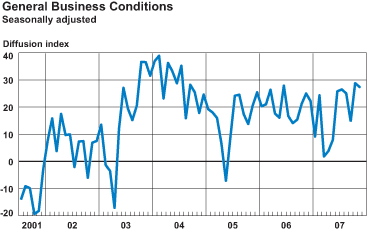| The monthly survey of manufacturers in New York State conducted by the Federal Reserve Bank of New York. |
November 2007 Report

The Empire State Manufacturing Survey indicates that conditions for New York manufacturers improved in November, at a pace close to that observed in October. The general business conditions index held steady at 27.4. The new orders and shipments indexes were also elevated and near last month’s levels. The prices paid index rose to its highest level in more than a year, while the prices received index was less elevated and declined modestly. Employment indexes, though positive, were markedly lower than in October. The degree of optimism regarding conditions six months ahead deteriorated: future activity indexes remained positive but dropped noticeably. The future prices paid index rose sharply to its highest level in considerably more than a year.
In a series of supplementary questions (see Supplemental Report tab), respondents were asked about their cash holdings and debt financing. Replying to a question about expected changes in their firms’ overall outstanding debt, 30 percent of respondents anticipated increases, while 33 percent expected declines. Nearly 39 percent of manufacturers expected cash holdings to increase over the next year, while 23 percent expected them to decline. In response to a related question about current cash holdings, just 16 percent of firms surveyed this month said that they were currently holding higher than usual (excess) cash balances—down from 25 percent in a similar survey conducted last November. When asked how they planned to finance capital expenditures over the next twelve months, manufacturers expressed a greater inclination to borrow than in the past.
Business Activity Remains Strong
After climbing significantly in October, the general business conditions index held its ground in November, at 27.6, with 47 percent of respondents reporting that conditions had improved. The new orders and shipments indexes also remained at elevated levels, the new orders index at 24.5 and the shipments index at 32.2. The unfilled orders index dipped slightly below zero, to -1.2. The delivery time index fell several points to -7.1, and the inventories index fell to -1.2.
The prices paid index rose markedly, to 42.9, its highest level in more than a year, with 45 percent of respondents reporting price increases. The prices received index was little changed, edging down just a few points to 11.9. Employment indexes fell sharply. The number of employees index, while positive—indicating a continued expansion in employment—fell for the first time since June, to 10.6. The average workweek index saw a steep decline, falling 19 points to 4.8.
Outlook Becomes Less Favorable
Future indexes were positive but deteriorated noticeably. The future general business conditions index fell 20 points, to 30.5. The future new orders and shipments indexes were also markedly lower than in October. The future prices paid index continued to advance, reaching 59.5, its highest level in well over a year. The future prices received index climbed as well, to 25.2. Future employment indexes, while positive, declined. The capital expenditures index fell several points to 19.1, and the technology spending index dipped 8 points to 11.9.










